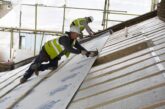
Debbie Phillips, National Business Development Manager for Keylite Roof Windows explores the forthcoming changes to Part L of the Building Regulations.
When it comes to energy efficiency in buildings, we can’t ‘cross that bridge when we come to it’ – it’s time to prepare for the changes now, according to Keylite. Whilst a product or design may say it meets Part L requirements, is that really good enough?
Late last year, the UK government announced a new target to reduce UK emissions by at least 68 per cent by 2030 and achieve net zero by 2050. As part of this goal, the government has uplifted energy efficiency standards and requirements, including proposals for revising the Approved Documents for Part L.
![]()
The purpose of approved document L is to ensure energy efficiency in buildings. The Target CO2 Emission Rate (TER) and Target Fabric Energy Efficiency (TFEE) rate are currently the minimum energy requirements for a new-build dwelling.
To showcase that a building complies with regulation requirements, Dwelling CO2 Emission Rate (DER) and Dwelling Fabric Energy Efficiency (DFEE) rates are calculated, and both must meet or exceed the TER and TFEE.
The detail is in the design – however, that shouldn’t just stop at drawings but should also translate into installation. Whilst a product may say it meets Part L or has a certain U-value, it’s important to ensure that this remains the case after it’s installed, which means mitigating the gap between performance on paper and the actual performance of a finished build.
To help with this, contractors should look to work with SAP assessments that integrate with Registered Construction Details, which can give a thorough and more accurate insight into the expected building performance. According to the Government Department for Energy, heat transfer through windows can account for up to 30 per cent of residential temperature energy usage.
When it comes to thermal efficiency and performance, one of the biggest issues for roof windows is thermal bridging. All too often double glazing is seen as the main culprit of this, however, despite meeting relevant standards it’s often in the installation of a product where cold bridging and condensation can occur.
Installation of roof windows is often left to the manufacturer’s discretion, with most stipulating that a gap is required around roof windows to allow for onsite adjustments and ease of installation. This gap is supposed to be ‘filled in’ after the window is installed to reduce the impact of thermal bridging, however, this is rarely stipulated in building designs, and retrofittable products such as thermal foam and collars are often not included in specifications.
It’s this gap between the roof and window that creates a cold section all around the frame due to the temperature differentiation between the outside and inside, which can eventually lead to mould and contributes toward heat loss.
To make houses more comfortable and energy efficient, the onus should be taken away from contractors, and products should be designed and specified with optimum performance in mind. Manufacturers should design-in features that eliminate thermal bridging, reducing the risk of non-compliance and delivering a build that is closer to the expected energy performance.
Keylite is aware of the issue surrounding the installation of roof windows and has taken the lead in ensuring it removes the possibility of this happening. Meaning its products are designed in such a way that contractors don’t have to consider the ‘gap’ when specifying or fitting roof windows.
With this principle in mind, an integrated expanding thermal collar for all its roof windows has been introduced as standard, at no extra cost. This is the only system of its kind and Keylite is the only company in the UK to address this issue in this way.
This integrated thermal collar is already attached to the roof window, so when on site, installers can fit with a 20mm gap for ease of installation and then simply pull the tab on the window once fitted to release the thermal collar.
The collar then expands to fill and fully insulate the gap, reducing the risk of condensation and cold bridging on the installed roof window. This not only saves time and cost for contractors on site, but also creates more thermally efficient and comfortable homes.
Keylite has always held installers’ wants and needs at the centre of its innovation and R&D processes; and as a result, the brand has become known for faster, easy-fitting products with enhanced thermal performance benefits straight from the box.
Full support is also provided by a highly skilled, experienced and technically knowledgeable sales department and aftersales care team, as well as an agile and enthusiastic sales force based across the UK, who can arrange first time installer site support programs.
For more information on Keylite Roof Windows’ integrated expanding thermal collar visit www.keyliteroofwindows.com/the-gap/







